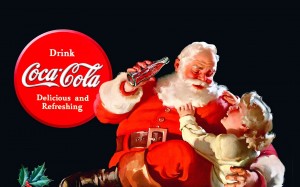JAMES ROBINSON
December 25th in most Western and some Eastern churches has long been the day on which Christians commemorate the birth of Jesus Christ. However, in recent years, Christmas has arguably become less of a commemorative religious event and more a modern brand capable of mobilising consumers in their billions with the irresistible allure of all things shiny, comforting and festive. It is now a tool that businesses and corporations use to enhance their marketing muscle with an injection of seasonal charm and sex appeal to leverage maximum spending.The origins of the Christmas brand image as we recognise it today can be traced back to Scandinavia when people would come to celebrate the winter solstice and the onset of lighter days. Fast forward to the Fourth Century AD, when church officials decided to make Jesus’ birthday a holiday and Pope Julius chose December 25th.
In the centuries that followed, significant brand developments have occurred including: the addition of the Christmas tree in the 1500s (German fir trees were decorated symbolising the paradise tree in the Garden of Eden), Santa Claus in the 1700s (Dutch colonists in New York changed the spelling of Sint Nikolaas to Sinterklaas) and American poet George Webster immortalising Santa as a citizen of the world by saying he lived at the North Pole, in his piece ‘Santa Claus and His Works’. The first company to fully seize the opportunity to leverage the Christmas brand was Coca-Cola, creating the first ads featuring Santa in 1931, illustrated by Haddon Sundblom. ‘The new Santa’ was introduced at the 1931 Macy’s Thanksgiving Day Parade. Whilst the general look of Santa had already been introduced in Thomas Nast’s illustrations, it was the Coca-Cola Santa that truly established him as the ubiquitous icon for Christmastime.

Coca-cola adopting a popular festive icon as a figurehead of their marketing strategy arguably marked the start of the large-scale commercialisation of Christmas and symbolizes a departure from the more traditional religious aspects of Christmas. Indeed, in an increasingly consumerist world where Christmas brand icons include images of Santa, reindeer, snowmen, Christmas elves and Penguins, there’s barely a Baby Jesus or an Angel Gabriel in sight.
Last year David Blunkett MP told the Radio Times: ‘Charles Dickens published “A Christmas Carol” in 1843, introducing the world to Ebenezer Scrooge and Tiny Tim. It remains perhaps the most popular Christmas fiction story of our time. But since it was written, it saddens me that Christmas has become so commercialised and over-hyped that its true meaning has become lost beneath the welter of fairy lights, tinsel and extravagant presents’.
It isn’t hard to see how household brands now employ some of the classic themes associated with Christmas such as togetherness, sharing, love and family to emotionally engage us and encourage us to make direct purchasing decisions.
The power of advertising to re-shape our view of a traditional event can be seen in some widely recognised ads – for instance, as showcased in this advert by Coca Cola, we now commonly associate the colours of green and red with the festive season and arguably they are now the official brand colours of Christmas.
‘Holidays are Coming’
In the UK, the John Lewis Christmas advert is now a national yearly event, ushering in the mass shopping season. This year’s stars a cute love-sick penguin, named Monty – who of course has now been heavily merchandised.
‘Give someone the Christmas they’ve been dreaming of’.
https://www.youtube.com/watch?v=iccscUFY860Sainsbury’s faithful recreation of the emotionally-charged First World War Christmas ceasefire has received much praise but has also been subject to criticism from viewers who believe that the advert was merely an insensitive and distasteful way to drum up sales.
‘Christmas is for sharing’
There can be no doubt that Christmas is one of the most, if not the most successful brands of all time, capable of harnessing all of our emotions and hard wiring them into a perceived need to buy stuff. If that statement sounds cynical, well, it’s because it is: so much about the Christmas brand has become superficial. Deep down we all know we’re being led blindly like moths towards the pretty lights, but that does not mean that we have to lose the essence of what makes Christmas special.
Amidst the shopping frenzies and fake snow, what is still undeniable is that Christmas can bring people together, families, friends and communities. It is an historic brand that has been hand-crafted by the people, for the people and it is open to interpretation. Whatever your traditions, however you wish to celebrate this time of year, religious or not, it is possible to do it without spending vast amounts of money just for the sake of it.
Ultimately, what has not been lost, is that for many of us, it is still a time to take stock, celebrate life and to remember what is really important in our lives.
February 10, 2025
January 28, 2025
December 9, 2024
September 29, 2024
August 9, 2024
July 22, 2024
May 10, 2024
April 27, 2024
November 20, 2023
October 20, 2023
September 13, 2023